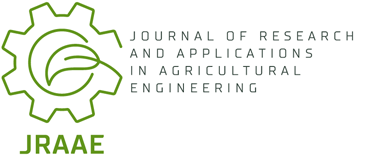Current issue
Online First
Archive
Instructions for Authors
Guide for Authors
Peer Review Policy
Research Ethics Policy
Ghostwriting and Guest Authorship
Copyright
Open Access Policy
Plagiarism
About the Journal
Aim and Scope
Scientific Board
Publisher
Editorial Board
Indexing in Databases
Personal Data Protection
Repository Policy
Contact
ORIGINAL PAPER
Deposition of copper depending on the spraying characteristics of winter oilseed rape
1
Wroclaw University of Environmental and Life Sciences, The Faculty of Life Sciences and Technology, Institute of Agricultural Engineering, ul. Chełmońskiego 37A, 51-630 Wrocław
Journal of Research and Applications in Agricultural Engineering 2018;63(1):13-17
KEYWORDS
ABSTRACT
The aim of the study was to determine the dependence of deposition of various forms of copper on winter oilseed rape on its spraying characteristics. The deposition of the utility liquid was determined in the first stage of the studies. The plants were sprayed in the spraying chamber “Aporo”, with the copper foliar fertilizer and nano-copper. The tests were performed with a working speed of 0.86 m·s-1, with two operating pressures 0.2 and 0.28 MPa. The spraying was done using standard nozzles: flat fan XR 110-02 and dual flat fan DF 120-02. In order to determine the deposition, the previously dried winter oilseed rape plants were mineralized, and then the concentration of the Cu element was measured using the spectrometer. The second stage of the study included the determination of the plant spraying coefficient Kpo. For this purpose, the photos of horizontal and vertical surfaces projections were taken of the winter oilseed rape crops in three phases of development. The surface area of the analysed plants was determined using the Scan2Cad and AutoCad 2014 graphical program. It was observed that the plant spraying coefficient Kpo increases along with the plants’ growth. For the applied spraying parameters, higher deposition values of copper were obtained by using Mikrovit Copper 80 foliar fertilizer for spraying.
REFERENCES (18)
1.
Anruszczak S., Kwiecińska-Poppe E., Kraska P., Pałys E.: The influence of some plant protection chemical means on leaf area and their tip angle of some winter spelt wheat varieties (Triticum aestivum ssp. spelta L.) Prog. Plant Prot., 2012, 52 (1), 163–166.
2.
Andruszczak S., Kraska P., Kwiecinska-Poppe E., Palys E., Szymona J., Krusinska B., Kisiel K.: Wpływ herbicydów i nawożenia dolistnego na kształtowanie się wskaźnika powierzchni liściowej (LAI) i średniego kąta nachylenia liści (MTA) oplewionej i nagoziarnistej formy owsa. Annales Universitatis Mariae Curie-Skłodowska, Sectio E, Agricultura, 2015, 70(1).
3.
Biskupski A., Kus A., Pabin J., Włodek S.: Wpływ zróżnicowanego nawożenia azotem na wskaźnik powierzchni liści (LAI), średni kąt nachylenia liści (MTA) i plon wybranych odmian pszenicy jarej. Annales UMCS sec. E Agricultura, 2004, 59 (2), 649–654.
4.
Biskupski A., Kaus A., Włodek S., Pabin J.: Zróżnicowane nawożenie azotem a plonowanie i wybrane wskaźniki architektury łanu kilku odmian pszenicy jarej. Inżynieria Rolnicza, 2007, 91 (3), 29–36.
5.
Czerednik A., Nalborczyk E.: Współczynnik wykorzystania napromieniowania fotosyntetycznie aktywnego (RUE) – nowy wskaźnik fotosyntetycznej produktywności roślin w łanie. Biuletyn IHAR, 2000, 215, 13–22.
6.
Garrigues S., Shabanov N., Swanson K., Norisette J., Baret F., Myneni R.: Inter comparison and sensitivity analysis of leaf area index retrievals from LAI-2000, AccuPAR, and digital hemispherical photography over croplands. Agric. For. Meteorol., 2008, 148 (8-9), 1193–1209.
7.
Gołębiowska H., Sekutowski T.: Ocena selektywności herbicydów stosowanych w monokulturze kukurydzy z wykorzystaniem wskaźnika powierzchni liści (LAI) i kąta nachylenia liści (MTA). Inżynieria Rolnicza, 2007, 91 (3), 51–58.
8.
Feledyn-Szewczyk B.: Porównanie konkurencyjności współczesnych i dawnych odmian pszenicy ozimej w stosunku do chwastów. J. Res. Appl. Agric. Engng, 2009, 54 (3), 60–67.
9.
Jaśkiewicz B.: Wskaźnik pokrycia liściowego (LAI) pszenżyta ozimego w zależności od jego obsady i nawożenia NPK. Acta Agrophys., 2007, 10 (2), 373–382.
10.
Kiełbasa P., Juliszewski T.: Pomiar powierzchni liści wybranych roślin metodą video-komputerową. Inżynieria Rolnicza, 2005, 74 (14), 169–175.
11.
Łuczycka D., Szewczyk A., Cieniawska B.: Charakterystyka opryskowa roślin jako przydatne kryterium doboru rozpylaczy do zabiegu. Zeszyty Problemowe Postępów Nauk Rolniczych, 2014, 577, 93–102.
12.
Oleksy A. Szmigiel A., Kołodziejczyk M.: Plonowanie oraz kształtowanie się powierzchni liści wybranych odmian pszenicy. Fragm. Agron., 2009, 26 (4), 120–131.
13.
Pietkiewicz J.: Wdrażanie kompleksowej ochrony ziemniaka w 1984. Power Plant., 1985, 9, 277–280.
14.
Prusiński J., Borowska M., Kaszkowiak E.: Wybrane wskaźniki produkcyjności roślin bobiku w warunkach wzrastającego nawożenia azotem. Biuletyn IHAR, 2008, 248: 105-116.
15.
Sekutowski T.: Application of bioassays in studies on phytotoxic herbicide residues in the soil environment. p. 253–272. In: Herbicides and Environment, Kortekamp A. (Ed.), 2011, Pub. InTech. Rijeka, Croatia.
16.
Szmigiel A., Oleksy A.: Wpływ kierunku siewu na powierzchnię asymilacyjną liści oraz plonowanie i zawartość białka w ziarnie pszenżyta jarego. Biul. Reg. AR Kraków, 1997, 314, 26–30.
17.
Weiss M., Baret F., Smith G., Jonckheere I., Coppin P.: Review of methods for in situ leaf area index (LAI) determination. Part II. Estimation of LAI, errors and sampling. Agric. For. Meteorol. 2004, 121 (1–2), 37–53.
18.
Woźniak A.: Wpływ zróżnicowanego udziału pszenicy jarej w zmianowaniu na indeks powierzchni liści (LAI). Acta Agrophys. 2011, 12 (1), 269–276.
Share
RELATED ARTICLE
We process personal data collected when visiting the website. The function of obtaining information about users and their behavior is carried out by voluntarily entered information in forms and saving cookies in end devices. Data, including cookies, are used to provide services, improve the user experience and to analyze the traffic in accordance with the Privacy policy. Data are also collected and processed by Google Analytics tool (more).
You can change cookies settings in your browser. Restricted use of cookies in the browser configuration may affect some functionalities of the website.
You can change cookies settings in your browser. Restricted use of cookies in the browser configuration may affect some functionalities of the website.


